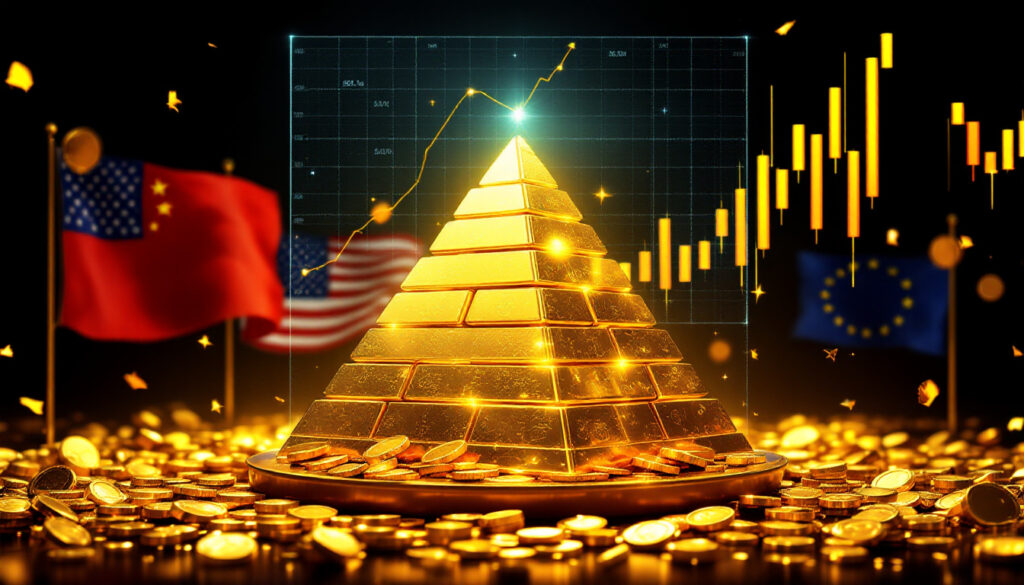How Do Tariffs Impact the Gold Market?
Gold has long been considered a safe-haven asset during times of economic uncertainty and geopolitical tensions. Recent price surges reflect this traditional flight to safety, with investors seeking protection against various economic risks, including those potentially created by tariff policies.
The gold market and tariffs relationship has become increasingly significant as global trade tensions rise. Understanding how these economic policies affect precious metals markets is crucial for investors navigating today's complex financial landscape.
The Traditional Safe-Haven Response
Gold's status as a reliable store of value continues to attract investors during periods of market volatility. When economic policies create uncertainty, particularly those affecting global trade relationships, investors often increase their gold holdings as a protective measure against potential currency devaluation and market instability.
The way tariffs impact markets extends beyond just gold. However, precious metals often demonstrate a particularly strong response to trade policy shifts due to their traditional role as crisis hedges.
Tariffs as Economic Policy Tools
Tariffs represent taxes imposed on imported goods, designed to protect domestic industries by making foreign products more expensive. While proponents argue they can help revitalize domestic manufacturing, critics point to potential unintended consequences including:
- Increased costs for businesses relying on imported materials
- Supply chain disruptions
- Potential retaliatory measures from trading partners
- Market uncertainty that drives safe-haven investing
Pre-tariff import surge data shows that U.S. imports spiked significantly in Q1 2024 as businesses rushed to stockpile goods ahead of anticipated tariffs, creating a historic trade deficit according to the U.S. Census Bureau's April 2024 report. This panic buying creates distortions that ripple through the gold market.
According to the National Federation of Independent Business (2024), approximately 68% of small import-reliant businesses reported supply chain disruptions directly attributed to tariff policies. As Jeffrey Tucker of the Brownstone Institute notes, "Tariffs hurt wholesalers and retailers, not consumers directly. Small businesses lack the margins to absorb these costs."
The global tariff impact has been substantial across various economies. From a technical perspective, tariffs are applied at the wholesale level, creating supply chain bottlenecks that distort inventory-to-sales ratios as tracked by Federal Reserve Economic Data (2024). This disruption often precedes gold price movements as market participants anticipate economic fallout.
The 2018 U.S.-China tariff situation provides a telling example: U.S. steel imports fell 12% post-tariff implementation, but domestic prices rose 28%, ultimately hurting downstream manufacturers according to U.S. International Trade Commission data from 2019.
Why Has Gold Been Reaching Record Prices?
The recent surge in gold prices can be attributed to multiple factors beyond just tariff concerns, creating a perfect storm for precious metals appreciation.
Economic Uncertainty Factors
- Inflation concerns: Despite some moderation, persistent inflation worries continue to drive investors toward hard assets
- Geopolitical tensions: Ongoing conflicts and trade disputes create market anxiety
- Central bank purchasing: Many national banks have increased gold reserves significantly
- Currency devaluation fears: Concerns about fiat currency stability amid massive debt levels
The record gold highs have been driven by a combination of these factors. Central bank gold purchases have been particularly significant, with the World Gold Council reporting 1,037 tonnes bought globally in 2023 alone. This institutional buying provides a strong floor for gold prices even during temporary market corrections.
From a performance perspective, gold has risen an impressive 68.7% over the five-year period from 2019-2024, outpacing the S&P 500's 49.2% return according to Bloomberg (2024). This outperformance highlights gold's value during uncertain economic times.
As Jeffrey Tucker observes, "Bitcoin hasn't replaced gold. It's still the ultimate hedge against monetary instability." This perspective reflects gold's enduring appeal even amid the rise of cryptocurrency alternatives.
A critical technical factor supporting gold price forecast has been negative real interest rates, which measured -1.2% in 2024 according to Federal Reserve data. These negative rates reduce the opportunity costs for holding non-yielding assets like gold.
The COVID-19 period from 2020-2022 demonstrated gold's resilience, with the metal rallying 40% during the unprecedented monetary expansion programs implemented by central banks worldwide (What tariffs mean for gold investors, 2023).
Statistical Evidence of Gold's Performance
| Period | Gold Price Movement | Key Contributing Factors |
|---|---|---|
| Q1 2024 | +15.3% | Trade tensions, recession fears |
| 2023 Full Year | +13.1% | Inflation concerns, geopolitical issues |
| 5-Year Period | +68.7% | Pandemic, economic uncertainty, institutional buying |
How Do Trade Deficits Influence Gold Markets?
Trade deficits represent the imbalance between a country's imports and exports, with more goods being purchased from abroad than sold internationally. These deficits can significantly impact currency valuations and, consequently, precious metals markets.
The Dollar Supremacy Challenge
The United States has maintained dollar supremacy in global markets for decades, but this has created certain economic imbalances:
- Higher labor costs relative to manufacturing competitors
- Increased reliance on imported goods
- Manufacturing decline in certain sectors
- Growing trade deficits that create economic vulnerabilities
The U.S. Bureau of Economic Analysis reported a Q1 2024 trade deficit of $1.1 trillion annualized, representing a striking 23% increase from Q4 2023. This ballooning deficit signals potential currency pressures that often benefit gold prices.
Jeffrey Tucker provides insight into this relationship by noting, "The dollar's dominance masks structural weaknesses. Trade deficits reveal reliance on debt-driven consumption." This fundamental imbalance creates underlying support for gold as a hedge against future dollar weakness.
Technical analysis from the National Bureau of Economic Research (2023) indicates that a 1% rise in the U.S. trade deficit correlates with a 0.6% increase in gold prices over a six-month period. This statistical relationship underscores gold's role as a trade deficit hedge.
The 1970s provide a historical parallel, when U.S. trade deficits contributed to gold's remarkable 400% price increase as the Bretton Woods monetary system collapsed (Federal Reserve History).
Gold as a Trade Deficit Hedge
Investors often view gold as protection against the potential consequences of persistent trade deficits:
- Currency devaluation risks
- Inflationary pressures
- Economic restructuring challenges
- Market volatility during policy adjustments
What Are the Unintended Consequences of Tariff Policies?
While tariffs are often implemented with specific economic goals in mind, they frequently produce unexpected outcomes that can ripple through markets, including precious metals.
Import Surges Before Implementation
One significant unintended consequence of announced tariff policies is the rush to import goods before the tariffs take effect:
- Businesses stockpile inventory to avoid future tariff costs
- Trade deficits temporarily balloon as imports surge
- Supply chains experience disruption
- Economic data becomes temporarily distorted
U.S. Census Bureau data shows that imports of Chinese goods rose 34% in February 2024 as businesses raced to beat potential tariff implementation dates. This surge created short-term economic distortions that influenced gold trading patterns.
Jeffrey Tucker highlights a particularly significant effect: "Tariffs created a 'statistical illusion' of recession via GDP distortions." This illusion often triggers safe-haven buying despite the underlying economic reality being more complex.
The Peterson Institute for International Economics (2024) notes that tariff-induced price hikes take 12-18 months to fully impact consumer inflation. This delayed effect creates prolonged uncertainty that typically supports gold prices well beyond the initial tariff announcement.
Business Impact Distribution
Tariff effects are not distributed equally across the business landscape:
- Small businesses: Often disproportionately affected due to less flexibility in supply chains and smaller margins
- Large corporations: May have more resources to adapt or absorb increased costs
- Wholesalers and retailers: Face immediate cost increases that may be difficult to pass on to consumers
- Domestic manufacturers: May benefit in some cases but could face higher input costs
The 2019 U.S. agricultural tariffs provide a telling example of unintended consequences: soybean exports to China fell 75%, requiring $28 billion in farmer bailouts according to USDA data from 2020. This type of market disruption creates economic uncertainty that typically favors gold as a safe-haven asset.
How Do GDP Measurements Affect Gold Market Perceptions?
Economic data, particularly GDP measurements, significantly influence market sentiment and investment decisions, including those related to precious metals.
GDP Calculation Limitations
Current GDP calculation methodologies contain inherent limitations that can distort economic reality:
- Exports count positively while imports count negatively, creating a misleading picture of productivity
- Government spending is counted as equivalent to private sector activity
- Inflation adjustments can significantly alter real vs. nominal growth perceptions
- Short-term statistical anomalies can create false recession signals
The Bureau of Economic Analysis reported Q1 2024 GDP at -1.5% annualized, driven largely by a 22% drop in government spending. This headline number triggered market concerns despite underlying economic strength in other sectors.
Jeffrey Tucker provides a critical perspective on this metric: "GDP counts government waste as productivity. It's a broken metric." This fundamental flaw in GDP calculation affects how markets interpret economic data and influences gold investment decisions.
A technical detail worth noting is that exports add 1:1 to GDP calculations, while imports subtract 1:1, creating a significant distortion in how trade policy outcomes are measured (BEA methodology). This calculation quirk can artificially depress GDP during periods of robust consumer spending on imported goods.
Gold's Response to Economic Data
Gold prices often react to economic data releases, but understanding the limitations of these measurements is crucial:
- Negative GDP readings may trigger gold buying even when underlying economic conditions are more complex
- Statistical illusions can create market movements disconnected from economic fundamentals
- Savvy investors look beyond headline numbers to assess true economic conditions
During the COVID-19 crash in Q2 2020, GDP fell 31.4%, yet gold hit $2,070/oz as investors fled equities according to World Gold Council data. This divergence demonstrates gold's complex relationship with economic indicators.
What Role Does Gold Play in Portfolio Diversification During Trade Tensions?
During periods of trade tensions and policy uncertainty, portfolio diversification becomes increasingly important for investors seeking to manage risk.
Gold's Traditional Diversification Benefits
Gold offers several key advantages as a portfolio diversification tool:
- Low correlation with traditional financial assets
- Inflation protection capabilities
- Currency devaluation hedge
- Geopolitical risk insurance
Bloomberg data (2024) shows that gold's correlation coefficient with the S&P 500 is -0.3 during trade wars, making it a particularly effective diversifier during periods of heightened tariff tensions.
Jeffrey Tucker emphasizes this unique characteristic: "Gold is the only asset that thrives when trust in institutions collapses." This quality makes gold especially valuable during periods of policy uncertainty and trade conflicts.
According to Morningstar's gold analysis (2023), a 10% allocation to gold reduces overall portfolio volatility by approximately 15%, providing significant risk-management benefits during turbulent market conditions.
The 2008 financial crisis offers a compelling example: gold rose 25% while global equities fell 40% (World Gold Council). This countercyclical performance illustrates gold's value as a portfolio stabilizer during market stress.
Allocation Strategies During Trade Tensions
Financial advisors often recommend specific allocation approaches during periods of trade policy uncertainty:
- Maintaining 5-15% portfolio allocation to precious metals
- Considering both physical gold and mining equities
- Balancing gold holdings with other hard assets
- Implementing dollar-cost averaging during market volatility
How Are Central Banks Responding to Economic Uncertainty?
Central banks worldwide have been significant players in the gold market, with their activities often reflecting broader economic concerns and strategies.
Record Central Bank Gold Purchases
Recent years have seen unprecedented central bank gold buying:
- 2023 saw central banks purchase over 1,000 tonnes of gold
- Diversification away from dollar-denominated assets continues
- Emerging market central banks have been particularly active buyers
- This trend creates additional demand pressure on gold prices
The gold market surge has been bolstered by these institutional purchases. The World Gold Council reports that China added 225 tonnes and Russia added 31 tonnes to their respective reserves in 2023 alone. This continued buying by major economic powers signals deep concern about traditional currency reserves.
Jeffrey Tucker observes that "Central banks are hedging against the dollar's erosion of purchasing power." This institutional perspective aligns with gold's traditional role as a store of value during currency uncertainty.
According to the IMF (2024), emerging markets now hold 35% of global gold reserves compared to 50% for developed nations, a significant shift from previous decades that reflects changing attitudes toward traditional reserve currencies.
Poland's 2024 gold acquisition provides a striking example: 130 tonnes were acquired specifically to "de-dollarize" reserves according to statements from the National Bank of Poland. This explicit move away from dollar dependence reflects growing concerns about U.S. monetary policy.
Monetary Policy Implications
Central bank policies regarding interest rates and monetary stimulus also significantly impact gold markets:
- Lower interest rates reduce the opportunity cost of holding non-yielding assets like gold
- Monetary expansion raises inflation concerns, benefiting gold
- Currency devaluation fears drive central banks toward hard assets
- De-dollarization efforts by some nations increase gold demand
What Are Expert Predictions for Gold in a Tariff-Heavy Environment?
Market analysts and economic experts offer varying perspectives on gold's outlook in an environment characterized by trade tensions and tariff policies.
Bull Case Scenarios
Positive outlooks for gold prices often cite:
- Continued economic uncertainty driving safe-haven demand
- Persistent inflation concerns despite central bank efforts
- Ongoing geopolitical tensions creating market anxiety
- Further central bank purchases supporting price levels
Goldman Sachs forecasts gold reaching $2,700/oz by Q4 2025 if tariffs persist, according to their April 2024 report. This bullish outlook is predicated on continued trade tensions and their ripple effects through the global economy.
Jeffrey Tucker offers this perspective on the bull case: "The bull case assumes policymakers keep making the same mistakes." This sardonic observation highlights how policy missteps often benefit gold prices.
Technical analysis from the CME Group (2024) indicates that every 1% increase in U.S. tariff revenue correlates with a 0.9% rise in gold futures prices. This statistical relationship underscores the market's perception of tariffs as inflationary and destabilizing.
The 2018-2019 period provides a relevant example: gold rose 18% during the U.S.-China tariff escalation according to Kitco data. This historical precedent suggests similar potential in the current trade policy environment.
Bear Case Considerations
More cautious perspectives highlight:
- Potential for resolution of trade tensions reducing safe-haven demand
- Higher interest rates increasing opportunity costs for holding gold
- Stronger dollar scenarios pressuring gold prices
- Technical corrections after significant price increases
How Can Investors Navigate Gold Markets During Trade Policy Shifts?
For investors seeking to capitalize on or protect against gold market movements during periods of trade policy uncertainty, several strategies merit consideration.
Technical Analysis Approaches
Chart-based investment strategies focus on:
- Identifying key support and resistance levels
- Monitoring volume patterns during price movements
- Recognizing potential consolidation phases
- Using moving averages to identify trend directions
TradingView data shows that gold's 200-day moving average held support at $1,950/oz in March 2024, providing a technical foundation for the subsequent rally. This type of technical level often serves as an entry point for investors during market pullbacks.
Jeffrey Tucker emphasizes a fundamental relationship: "Watch real rates—when they're negative, gold outperforms." This insight connects technical price movements to underlying economic conditions.
S&P Global (2024) reports that gold mining all-in sustaining costs (AISC) average $1,300/oz, providing a theoretical price floor below which production would become uneconomical. This cost structure informs technical support levels.
Options trading during 2023 showed volatility skewed toward calls during Federal Reserve policy uncertainty according to CBOE data. This options activity provides clues about market sentiment and potential price directions.
Fundamental Analysis Considerations
Fundamentals-focused investors should monitor:
- Real interest rate trends (nominal rates minus inflation)
- Central bank policy signals
- Physical gold demand from major markets like China and India
- Mining supply constraints and production costs
FAQ: Gold Markets and Trade Policies
Does gold always rise during periods of tariff implementation?
While gold often benefits from the uncertainty created by significant trade policy shifts, the relationship isn't automatic
Want to Stay Ahead of the Next Major Mineral Discovery?
Discover why significant mineral discoveries can lead to exceptional market returns by exploring Discovery Alert's dedicated discoveries page. Start your 30-day free trial today and receive real-time alerts on ASX mineral discoveries, powered by the proprietary Discovery IQ model that transforms complex data into actionable investment opportunities.




